Figure 1: Merchant distance varied substantially across Chicago neighborhoods in Q2 2016
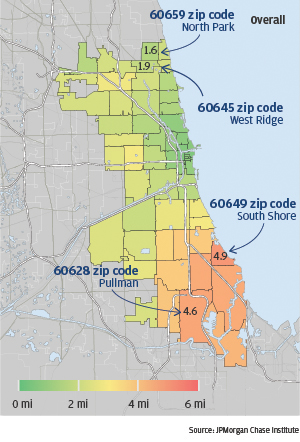
With a GDP of $651 billion1 and retail sales of $128 billion2, the Chicago metropolitan area is the largest economy in the US Midwest, the third largest in the US, and an important hub in the global economy. Moreover, the Chicago economy is a leading contributor to the small business sector—small businesses with fewer than 500 employees in the metro area created 270,034 jobs in 2014.3
While the overall economy in Chicago is strong, it is not equally strong across all of its neighborhoods, which may limit the inclusion of all Chicago residents in the city’s growth. Most neighborhoods on the South and West Side of Chicago have poverty rates over 15 percent, and many have poverty rates over 30 percent (Heartland Alliance, 2017). Leaders and decision makers seeking timely geographically granular data and insights about economic vibrancy or challenges have few resources to turn to, and accordingly are limited in their development of targeted policies and solutions to support these neighborhoods.
With these challenges and opportunities in mind, the JPMorgan Chase Institute leveraged its de-identified Local Consumer Commerce and Small Business data assets to provide new insights about the Chicago economy at the neighborhood level. We use merchant distances to compare retail access across Chicago neighborhoods by product type and by resident income, and cash buffer days to assess the cash liquidity of small businesses in these same areas. We find meaningful differences between the commercial vibrancy of neighborhoods on Chicago’s South and West Sides and neighborhoods downtown and on the North Side neighborhoods. Data about these differences may help local leaders develop targeted policies that support economic growth for Chicago residents across all of its neighborhoods.
As a first lens on the heterogeneity of the Chicago economy by neighborhood, we consider the distance that residents travel when purchasing goods and services. In a recent analysis, the JPMorgan Chase Institute introduced a new approach for understanding the economic vitality of neighborhoods by using credit and debit card data to measure the distance between the home of a consumer and the merchants where she makes purchases (Farrell, Ward and Relihan, 2017). Rather than simply identifying the presence of different kinds of retail and service establishments in a given neighborhood, this approach identifies the places that residents actually shop—providing a view into the providers that provide the goods and services that residents want or need at an appropriate price. This approach focuses on the typical merchant distance, which we define for every transaction as the geographic distance between the center of the resident’s zip code and the center of the merchant’s zip code.
In this sense, the variety of goods, services, and other amenities easily available for consumption in or near a neighborhood provide an additional lens on the vitality and revitalization of a neighborhood. Moreover, to the extent that Chicago residents consume at merchants near their places of employment, merchant distance and retail access inform the ways in which neighborhood development and workforce opportunities interact. We used the merchant distance approach to analyze retail access across Chicago neighborhoods using consumer transactions in the second quarter of 2016. Figure 1 presents the median merchant distance for all such transactions by zip code. The results suggest substantial heterogeneity in retail access across neighborhoods in access to nearby amenities, goods and services. Residents of many neighborhoods on the South Side travelled substantial distances to consume goods and services. The typical transaction from a resident in the 60649 zip code (South Shore) occurred at a merchant 4.9 miles away, while the typical transaction from a resident in the 60628 zip code (Pullman) occurred at merchant 4.6 miles away. In contrast, residents of neighborhoods of North Side neighborhoods had substantively closer access to retail. The typical transaction from a resident in the 60645 zip code (West Ridge) and the 60659 zip code (North Park) was at merchant 1.9 and 1.6 miles away, respectively.
Figure 1: Merchant distance varied substantially across Chicago neighborhoods in Q2 2016

Figure 2: Consumers shopped closer to home for their groceries, except in some South Side neighborhoods
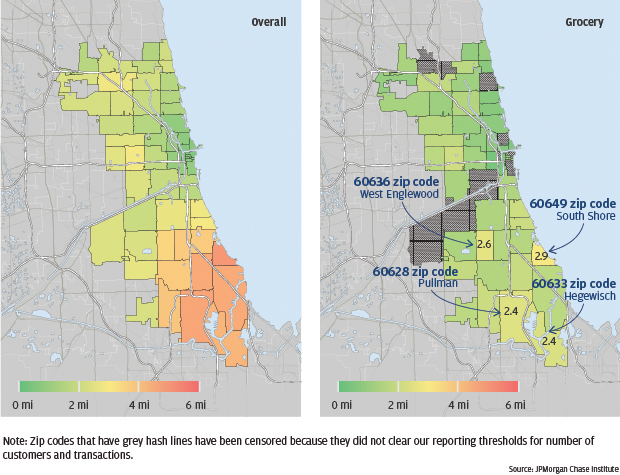
Figure 3 presents merchant distance by zip code for restaurants. The overall pattern suggests that in contrast to grocery stores, consumers tend to make purchases at restaurants that are farther from home. Differences in merchant distance are more dispersed by neighborhood than distances for other product types—residents in some Chicago neighborhoods travelled substantially further to restaurants than others. These differences are especially pronounced in comparisons between neighborhoods on the North and South Sides. For instance, the median merchant distance in the 60614 zip code shows that the Lincoln Park residents eat at restaurants 1.4 miles from their homes. In contrast, the median merchant distance in the 60617 and 60633 zip codes suggest that residents of Hegewisch and South Chicago eat at restaurants 6 miles from home.
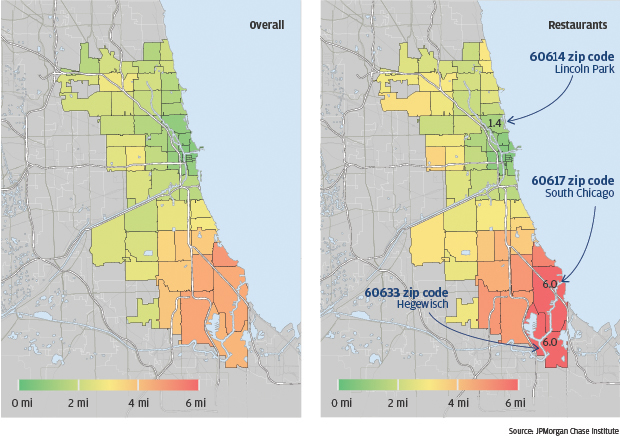
In addition to providing views by product type, merchant distance data can also inform retail access by different groups of consumers. Figure 4 compares median merchant distances for low-income consumers in the bottom 40 percent of the income distribution to median merchant distances for high-income consumers in the top 40 percent of the income distribution. Notably, high income residents of South and West Side neighborhoods travel substantially farther than low income residents of the same neighborhoods, while merchant distances for high and low income residents in North Side neighborhoods are largely the same.
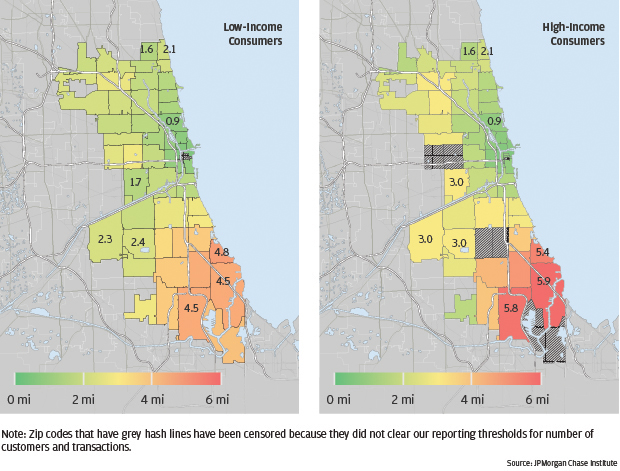
For example, the median merchant distance in the 60617 zip code was 5.9 miles for high-income residents, but 4.5 miles for low-income residents, indicating that high-income residents of South Chicago travel 1.4 miles farther for goods and services than their low-income neighbors. Likewise, the median merchant distance in the 60623 zip code was 3 miles for high-income residents for high-income residents, but 1.7 for low-income residents, suggesting that high-income residents of Lawndale travel 1.3 miles farther for goods and services than their low-income neighbors. In contrast, the median merchant distances in the 60645, 60626, and 60614 zip codes on the North Side were exactly the same for high-income residents and low-income residents at 1.6 miles, 2.1 miles, and 0.9 miles, respectively.
Differences in resident unemployment rates and local work opportunities (Wilson, 1996) may in part reflect these differences across regions of the city, to the extent that the geography of retail activity is shaped by where people work. Higher-income residents of South Side and West Side neighborhoods may have employment opportunities downtown or otherwise far from their homes that may not be available to their lower-income neighbors. In contrast higher-income residents of North Side neighborhoods may have employment opportunities much closer to home.
The financial well-being of local small businesses provides a complementary view of economic vibrancy of neighborhoods across Chicago. Small businesses play an important role in inclusive economic growth. Businesses with fewer than 250 employees are a key source of employment, providing jobs for 58 percent of Chicago residents overall and 70 percent of jobs for inner city Chicago residents (Initiative for a Competitive Inner City, 2016). While these small businesses create jobs and provide goods and services for neighborhood residents, most are financially fragile.
In recent research, the JPMorgan Chase Institute analyzed the financial fragility of small businesses by measuring their cash buffer days (Farrell and Wheat, 2016). Specifically, we measure cash liquidity by identifying the typical number of cash buffer days for small businesses in Chicago neighborhoods in June 2016. Cash buffer days are the number of days of cash outflows a business could pay out if its cash balance were its inflows to stop. We estimate cash buffer days for a business by computing the ratio of its average daily cash balance to its average daily cash outflows. Overall, most businesses across the U.S. metro areas have a limited cash buffer. Among a sample of over 50,000 small businesses we identified in the Chicago metro area in Q2 2016 most had 14 or fewer cash buffer days. We used these data to explore cash liquidity and financial fragility across Chicago neighborhoods.4
Figure 5 shows that while many small businesses throughout Chicago operate on a limited cash buffer, small businesses in many South and West Side neighborhoods have the most limited cash reserves. For example, in the 60621 zip code half of small businesses hold 5 or few cash buffer days, suggesting that many small businesses in Englewood are operating with less than a week of cash reserves in their deposit accounts. In contrast, in the 60613 zip code, half of small businesses held at least 17 cash buffer days, suggesting that many small businesses in Buena Park carry three times the cash liquidity of their peers in Englewood. While 17 days still reflects a relatively small buffer relative to the amount of time it might take to apply for and receive credit in the face of an unexpected cash shortfall, it is decidedly longer than the week that many businesses on the South and West side would have to do the same.
Figure 5: Small businesses across Chicago had limited cash liquidity, but especially so on the South and West Sides
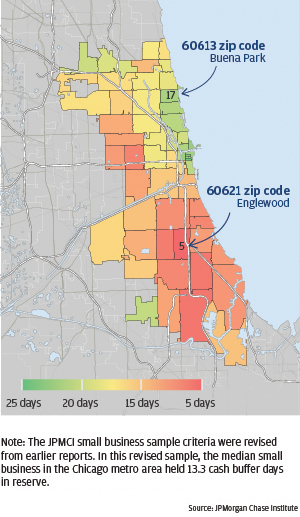
Taken together, retail access and small business cash liquidity data provide a novel, geographically granular, and multi-faceted view of differences in commercial vibrancy across Chicago neighborhoods. Residents of many neighborhoods on the South and West Side of Chicago frequently travel substantially farther than residents of North Side neighborhoods for retail goods and services. Typical transaction distances of over two miles for grocery stores and four miles for restaurants suggest that many South and West Side residents purchase these basic goods and services well outside of their local neighborhoods, while many North Side residents make these purchases much closer to home. Moreover, while higher income South and West Side residents who may have increased purchasing power are even more likely to make purchases outside of their communities, the geographic consumption patterns of North Side residents are virtually indistinguishable by income. This suggests that, as compared to neighborhoods on the North Side, a disproportionately low share of income that flows into South and West Side neighborhoods is spent locally.
Our neighborhood-level view of small business cash liquidity corroborates these city-wide differences in commercial vibrancy. Small businesses in the South and West Side neighborhoods where residents—and particularly high income residents—shop farthest from home hold the fewest cash buffer days in reserve. In contrast, small businesses in neighborhoods on the near North Side where residents shop closest to home have the largest cash buffers. While our analyses do not provide a causal link between small business cash buffer days and merchant distance, it is certainly notable that the most financially fragile businesses are in neighborhoods where residents are least likely to shop near home.
These results suggest a potentially mutually reinforcing set of policy opportunities for leaders and decision makers seeking to promote inclusive economic growth. Many policymakers have proposed interventions to bolster the economic well-being of small businesses in underserved communities. Programs designed to ease small business access to capital, tax incentives targeted at specific neighborhoods, and technical programs all have the potential to increase the financial resilience of small businesses. In addition, these initiatives may increase local production of goods and services and lower merchant distance in these neighborhoods.
Leaders have also shown interest in innovations intended to encourage residents to engage in commercial activities close to their homes. To this end, policymakers have considered and implemented programs like the 20-minute neighborhood in cities like Portland, OR and Detroit. While these programs may have a first-order effect of reducing merchant distance in many neighborhoods, they may also bring additional revenues to local small businesses and reduce their financial fragility.
With a continued focus on neighborhood-level indicators of both local consumption behavior and the economic and financial performance of local small businesses, policy makers may have new opportunities not only to further the overall economic development of Chicago, but to support inclusive economic growth that strengthens all communities across the city.
Farrell, Diana and Christopher Wheat. 2018. “The Commercial Vibrancy of Chicago Neighborhoods, 2016.” JPMorgan Chase Institute.
Farrell, Diana and Christopher Wheat. 2016. “Cash is King: Flows, Balances, and Buffer Days.” JPMorgan Chase Institute. https://www.jpmorganchase.com/insights/business-growth-and-entrepreneurship/report-cash-flows-balances-and-buffer-days
Farrell, Diana, Relihan, Lindsay and Marvin Ward. 2017. “Going the Distance: Big Data on Resident Access to Everyday Goods.” JPMorgan Chase Institute. https://institute.jpmorganchase.com/content/dam/jpmc/jpmorgan-chase-and-co/institute/pdf/institute-access-to-consumption-brief.pdf
Heartland Alliance, 2017, “Cycle of Risk: The Intersection of Poverty, Violence, and Trauma”. https://www.heartlandalliance.org/povertyreport/wp-content/uploads/sites/26/2017/03/FINAL_PR17_3_14.pdf
Initiative for a Competitive Inner City. 2016. “The Big Impact of Small Businesses on Urban Job Creation: Evidence from Five Cities”. http://icic.org/wp-content/uploads/2016/10/JPMC_R1_BigImpact_FINAL_forpost.pdf
Wilson, William J. 1996. When Work Disappears: The World of the New Urban Poor. New York: Knopf.
This effort would not have been possible without the critical support of the JPMorgan Chase Intelligent Solutions team of data experts, including Gaby Marano, Stella Ng, Michael Harasimowicz, and Bill Bowlsbey, and JPMorgan Chase Institute team members including Marvin Ward, Caitlin Legacki, Courtney Hacker, Gena Stern, Sruthi Rao, Alyssa Flaschner, Jolie Spiegelman, Natalie Holmes and Kelly Benoit.
We would like to acknowledge Jamie Dimon, CEO of JPMorgan Chase & Co., for his vision and leadership in establishing the Institute and enabling the ongoing research agenda. Along with support from across the firm—notably from Peter Scher, Len Laufer, Max Neukirchen, Patrik Ringstroem, Joyce Chang, and Judy Miller—the Institute has had the resources and support to pioneer a new approach to contribute to global economic analysis and insight.
U.S. Bureau of Economic Analysis 2016.
U.S. Department of the Census, Economic Census, 2012.
U.S. Department of the Census, Business Dynamics Series, 2014.
In the sample produced by the sample criteria used in the original Cash is King report, we reported that the median small business in our sample carried 27 cash buffer days. We have subsequently refined and revised our sample criteria. The 13.3 cash buffer days carried by the median small business in the Chicago metro area in 2016 Q2 is typical of these new sample criteria when applied to other cities.
Authors

Diana Farrell
Founding and Former President & CEO

Chris Wheat
President, JPMorganChase Institute